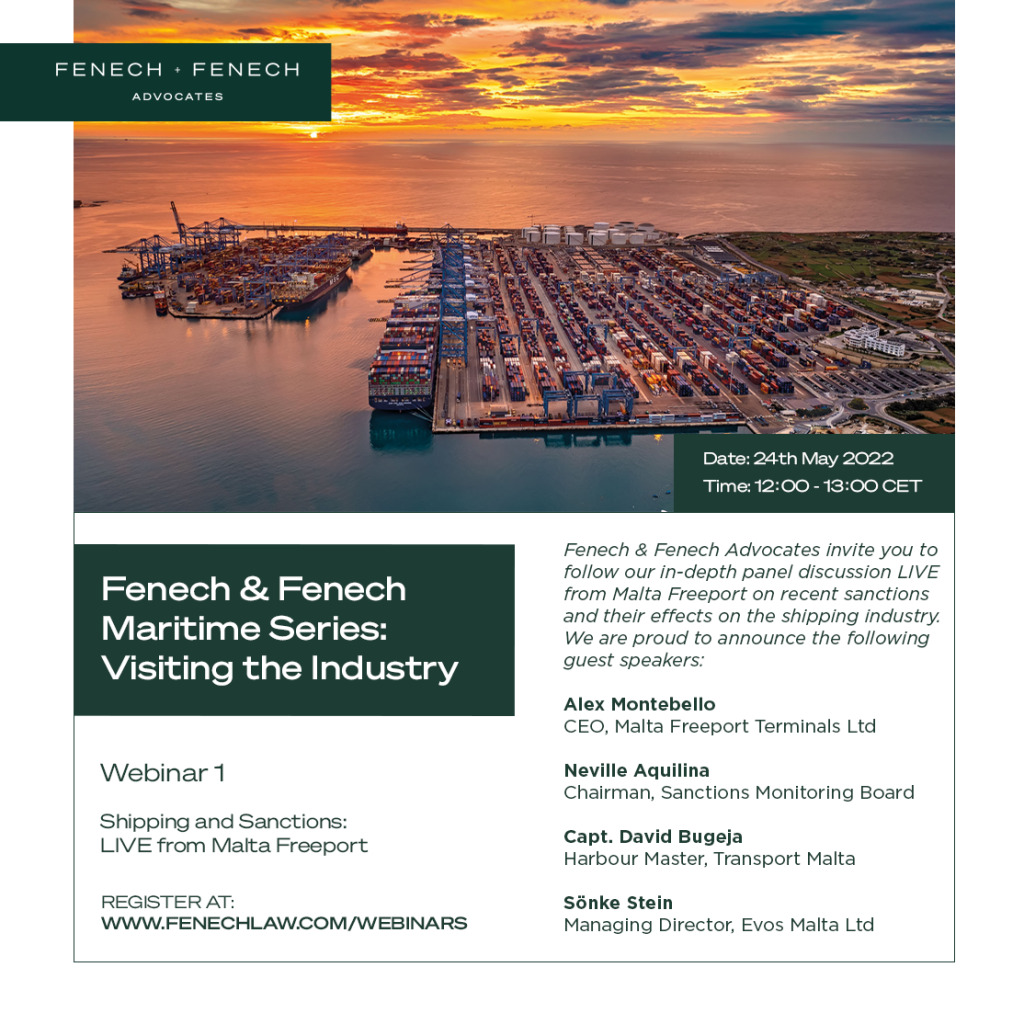
This is the second article in a series published by Fenech & Fenech Advocates focusing on the decarbonisation of the shipping sector, with specific emphasis on the EU Emission Trading System.
Initial steps at Compliance
In the evolving landscape of global shipping, the maritime industry is adapting to significant changes with the integration of maritime transport into the EU Emission Trading System (‘EU ETS’). Shipping companies are now grappling with these new responsibilities jointly imposed by the EU ETS Directive (2003/87/EC) and the Monitoring Reporting and Verification Regulation (‘MRV’) (2015/757).
Primarily, the key tasks relate to assigning ETS/MRV responsibilities, which include first and foremost identifying the shipping company and in turn their relevant administering authority. Additionally, shipping companies are required to revise their monitoring plans, and submit them to verifiers through the THETIS-MRV platform. Another crucial step for compliance with the EU ETS, involves requesting the opening of a Maritime Operator Holding Account (‘MOHA’) with the relevant administering authority.
Time-sensitive deadlines continue to loom on the horizon for shipping companies. By April 1, 2024, or within three months after each ship’s initial port call in a Member State’s jurisdiction, shipping companies were mandated to submit their assessed monitoring plans for approval by their administering authority. Furthermore, by March 31, 2025, companies must submit their verified emissions reports, marking a critical milestone in the transition being imposed by the EU on the maritime industry.
Identifying the Shipping Company
The shipping company is the entity responsible for surrendering EU allowances to the Union Registry.
The question is: how and who should be recognised as the shipping company? While seemingly straightforward, the legal framework introduces added complexity to this definition.
The ‘shipping company’ is commonly defined in Article 3(w) of the EU ETS Directive and Article 3(d) of the MRV Regulation wherein it is stated that it is;
‘the shipowner or any other organisation or person, such as the manager or the bareboat charterer, that has assumed the responsibility for the operation of the ship from the shipowner and that, on assuming such responsibility, has agreed to take over all the duties and responsibilities imposed by the International Management Code for the Safe Operation of Ships and for Pollution Prevention, set out in Annex I to Regulation (EC) No 336/2006 of the European Parliament and of the Council.’
The definition of a shipping company seems to offer two potential options. Firstly, it identifies the registered owner as the primary entity to be recognised as a shipping company. The registered owner is considered as the entity specified on the ship’s certificate of registry and is assigned an IMO Unique Company and Registered Owner Identification Number. Therefore, on the surface, it appears that any other entity, such as a parent or sister company within the same corporate structure of the registered owner’s entity, should not be classified as registered owners and consequently cannot be deemed as a shipping company. However, further investigation reveals that certain national administrators have adopted their own interpretation of the definition of a registered owner and seem to permit an extended definition of such.
Other than the registered owner, the definition provides that a shipping company can be any organisation or person that has taken on the duties and responsibilities imposed by the ISM Code, essentially referring to the Document of Compliance (DOC) Holder.
For this to take place, Commission Implementing Regulation (EU) 2023/2599 stipulates that the registered owner and the ISM company must enter into a signed agreement. In this agreement, the ISM company must explicitly indicate that it has been duly mandated by the shipowner to comply with the EU ETS and MRV obligations. In addition, the definition also includes mention of the bareboat charterer. This is where we come across a rather significant challenge in the correct interpretation of this. One restrictive interpretation is that a bareboat charterer is only considered the shipping company if;
- It takes on the responsibility under the ISM Code and is therefore the DOC Holder and
- If it obtains a mandate from the registered owner wherein an agreement is reached that the Bareboat Charterer is to take on the responsibilities for both EU ETS and MRV.
However, in our humble opinion, it is highly likely that this interpretation will lead to numerous complications due to the fact that, as is well known in the industry, numerous bareboat charterers are not DOC Holders and at the same time the ISM Managers do not want to be burdened with EU ETS obligations. An alternative interpretation should be considered, wherein bareboat charterers assume responsibility for EU ETS compliance without necessarily being the DOC Holder.
If the registered owner decides to assume responsibility for ETS and MRV obligations personally, he must provide the administering authority with a list of ships for which he has assumed responsibility. Similarly, the ISM company must also provide such a list, along with the aforementioned mandate evidencing the agreement with the registered owner.
Identifying the Administering Authority
Attributing a shipping company to an administering authority is essential for it to fulfill its ETS obligations, both operationally and legally. The guiding principle for determining the administering authority is that every shipping company operating within the EU ETS and aiming for compliance must be linked with the administering authority of one Member State.
The Commission has published the long-awaited attribution list through Commission Implementing Decision (EU) 2024/411. This list comprises shipping companies and their relevant administering authorities, indicating the particular member state associated with each. The EU ETS Directive establishes the criteria for determining this list, relying on data available on THETIS-MRV and, when necessary, port call history data from SafeSeaNet. Inclusion or exclusion from the list is not in any way determinative of compliance with the EU ETS. Companies not listed will nonetheless need to assess what this means for them and if they are responsible for EU ETS compliance in any event.
It’s crucial to understand that the shipping companies listed on the attribution list are the regulated entities rather than the individual ships. Changes in a shipping company’s fleet do not affect the attribution list, which undergoes revision every two years.
If a shipping company is not listed, it must determine its administering authority according to the EU ETS Directive, specifically Article 3gf. If the Directive assigns a shipping company to a particular member state, the company should create a user account in the Thetis-MRV system, add the new company to the user account, and then follow the necessary steps to attribute the new company to an administering authority.
Final remarks
In conclusion, the EU ETS has introduced a significant layer of complexity for the maritime industry. The industry has transitioned from preparation to implementation, unveiling a host of new challenges. Highlighted throughout this text is the importance of untangling certain uncertainties when navigating EU ETS compliance. Crucially this entails identifying the appropriate “shipping company” as the initial step and in turn identifying its relevant administrative authority. With these foundations in place, companies can systematically address subsequent obligations, such as the submitting of their assessed monitoring plan and the request to have a MOHA opened for subsequent allowance surrendering purposes.
For further information on this topic please contact Ann Fenech or Daniel-Luc Farrugia at Fenech & Fenech Advocates by email (ann.fenech@fenechlaw.com or daniel.farrugia@fenechlaw.com). The Fenech & Fenech website can be accessed at www.fenechlaw.com.















